Joe McShea and Edgar Mosa’s Flags
TEXT BY STEPHEN TRUAX
PHOTOGRAPHY BY THOMAS McCARTY
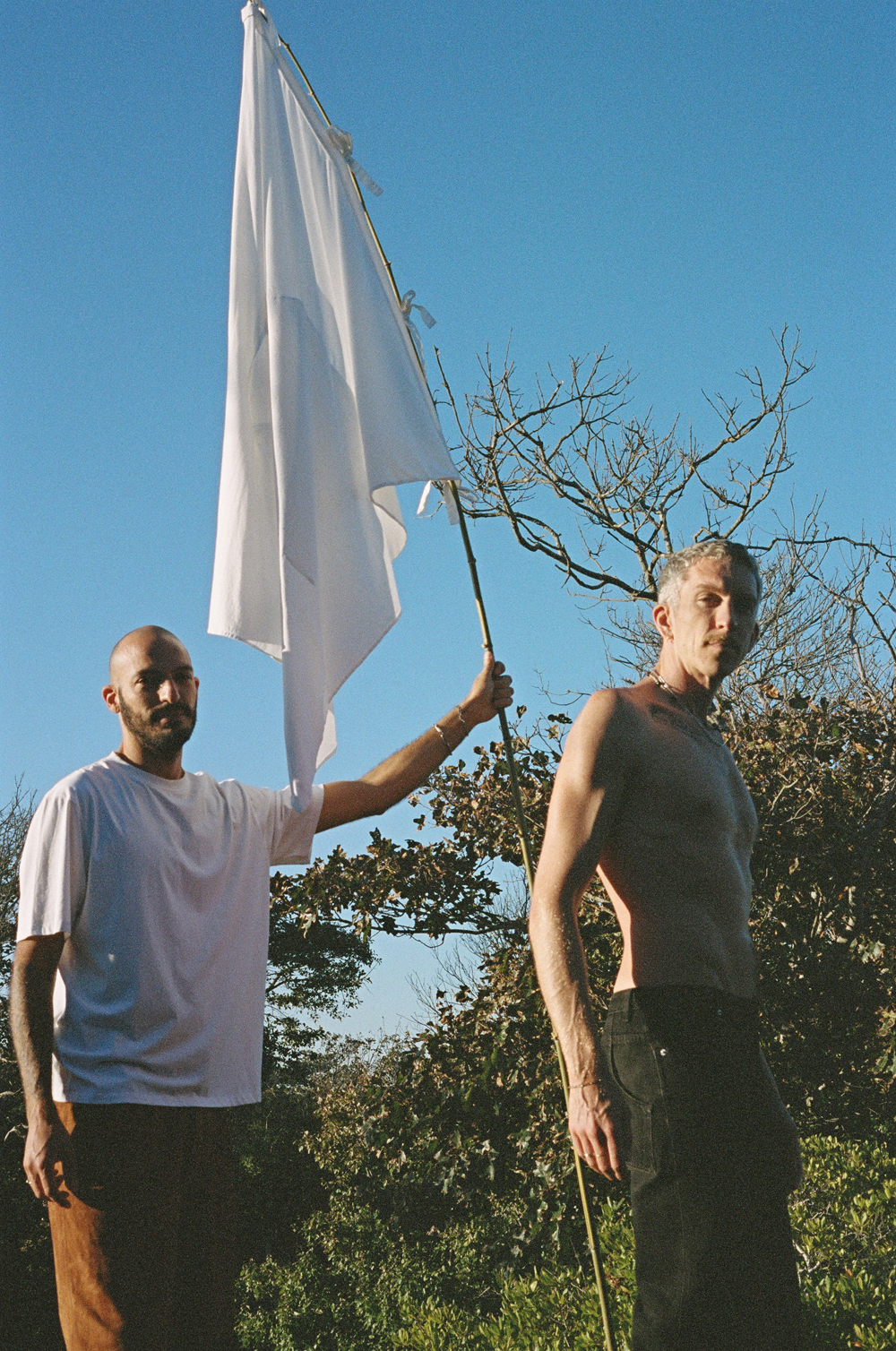
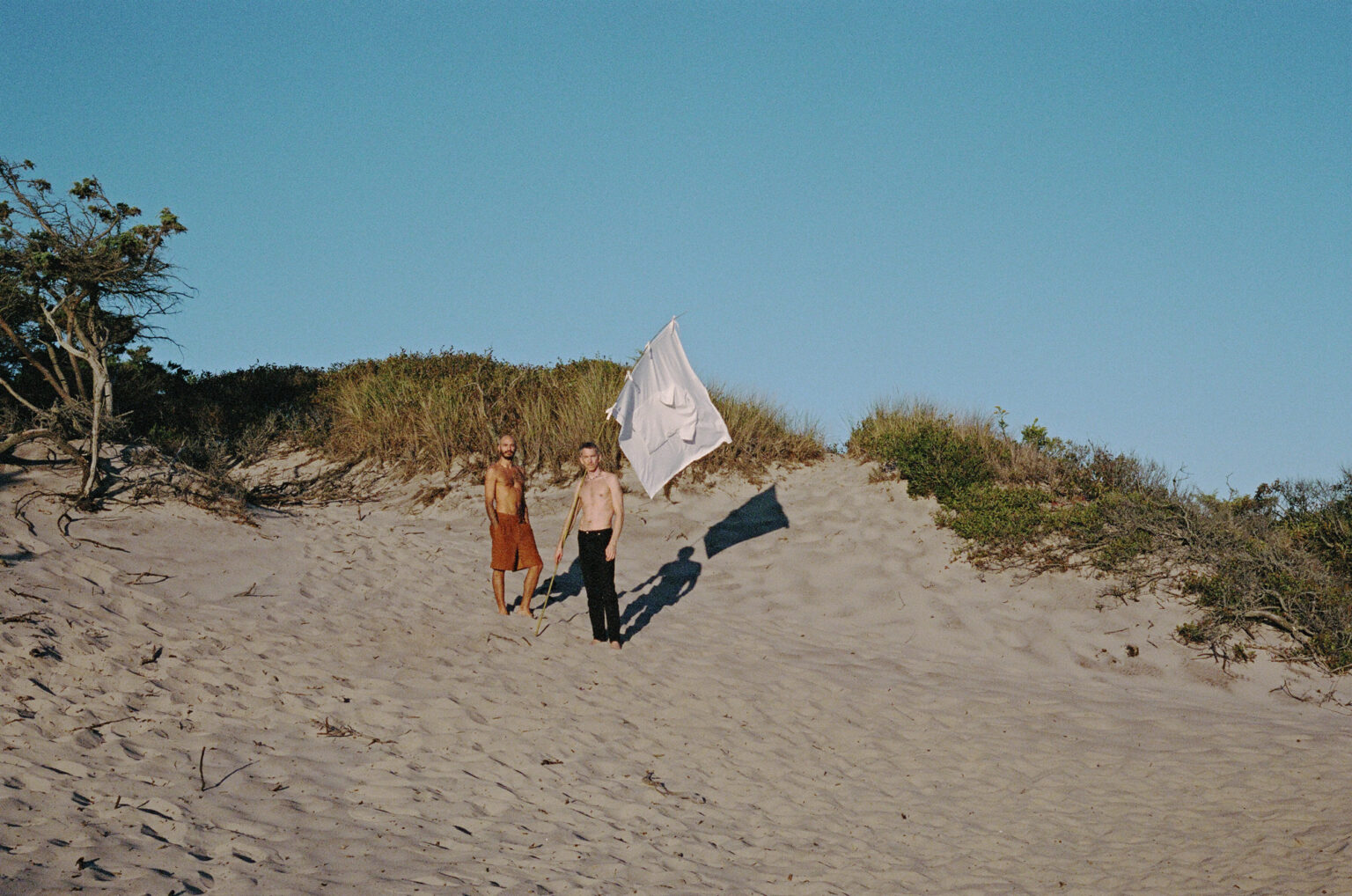
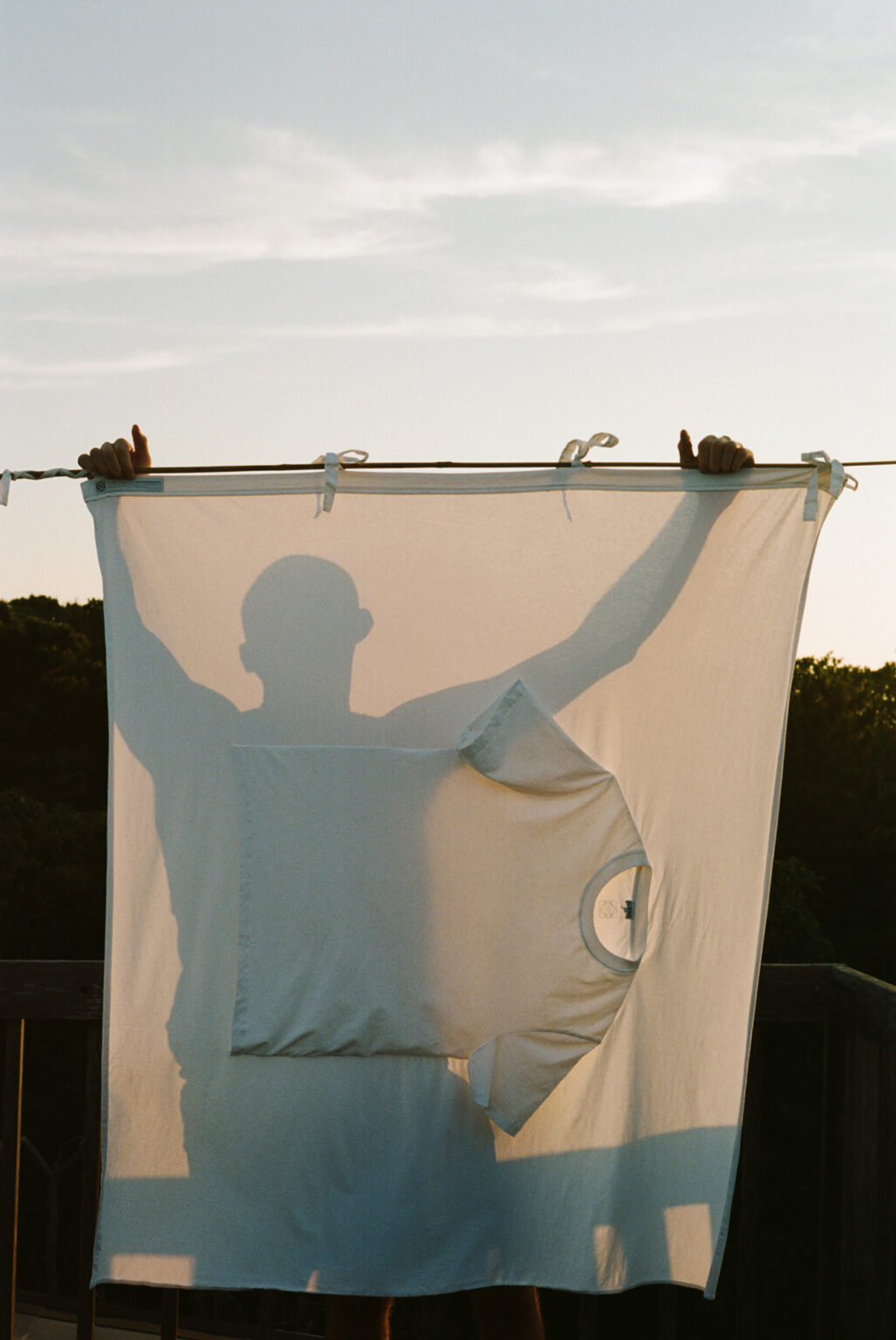

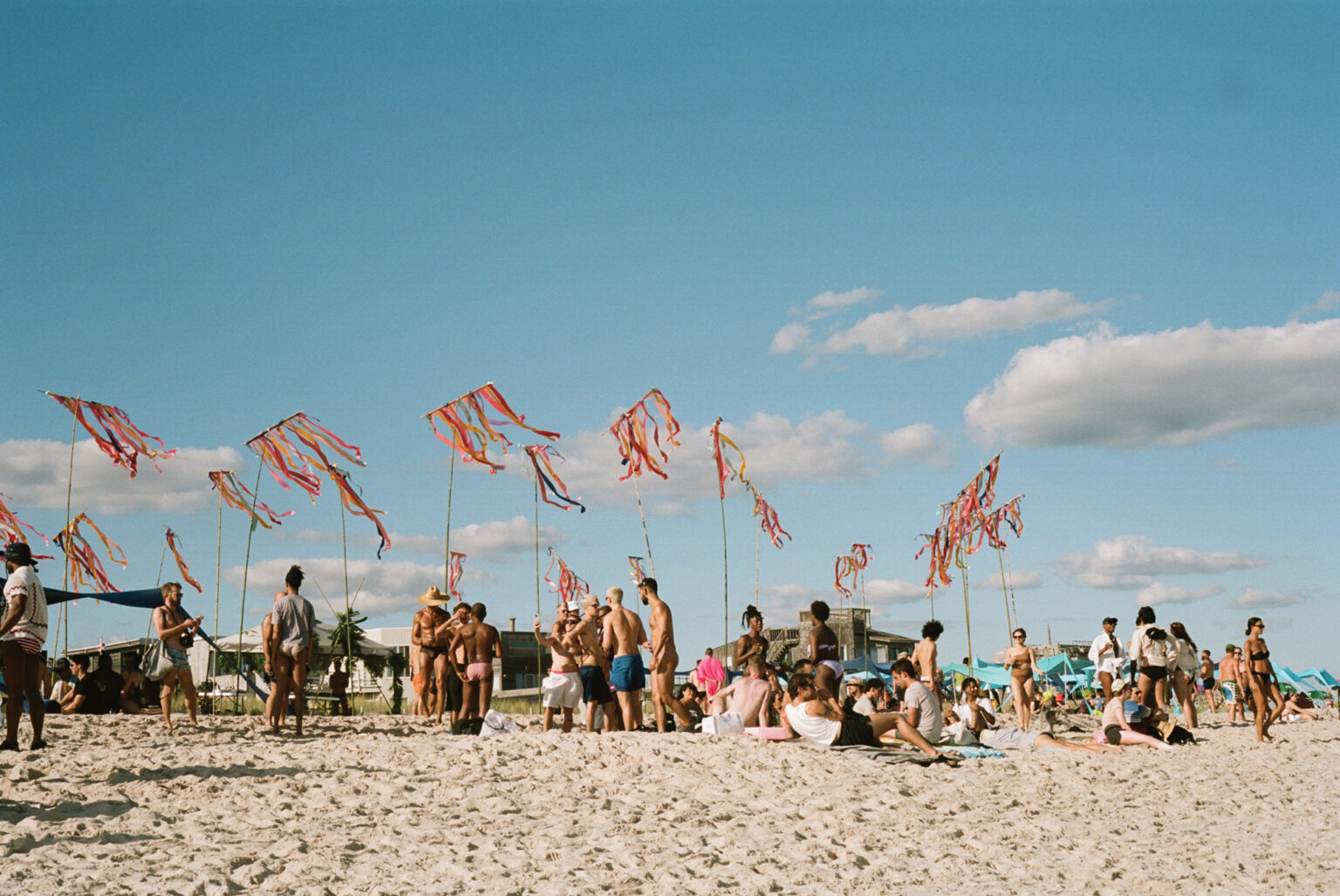
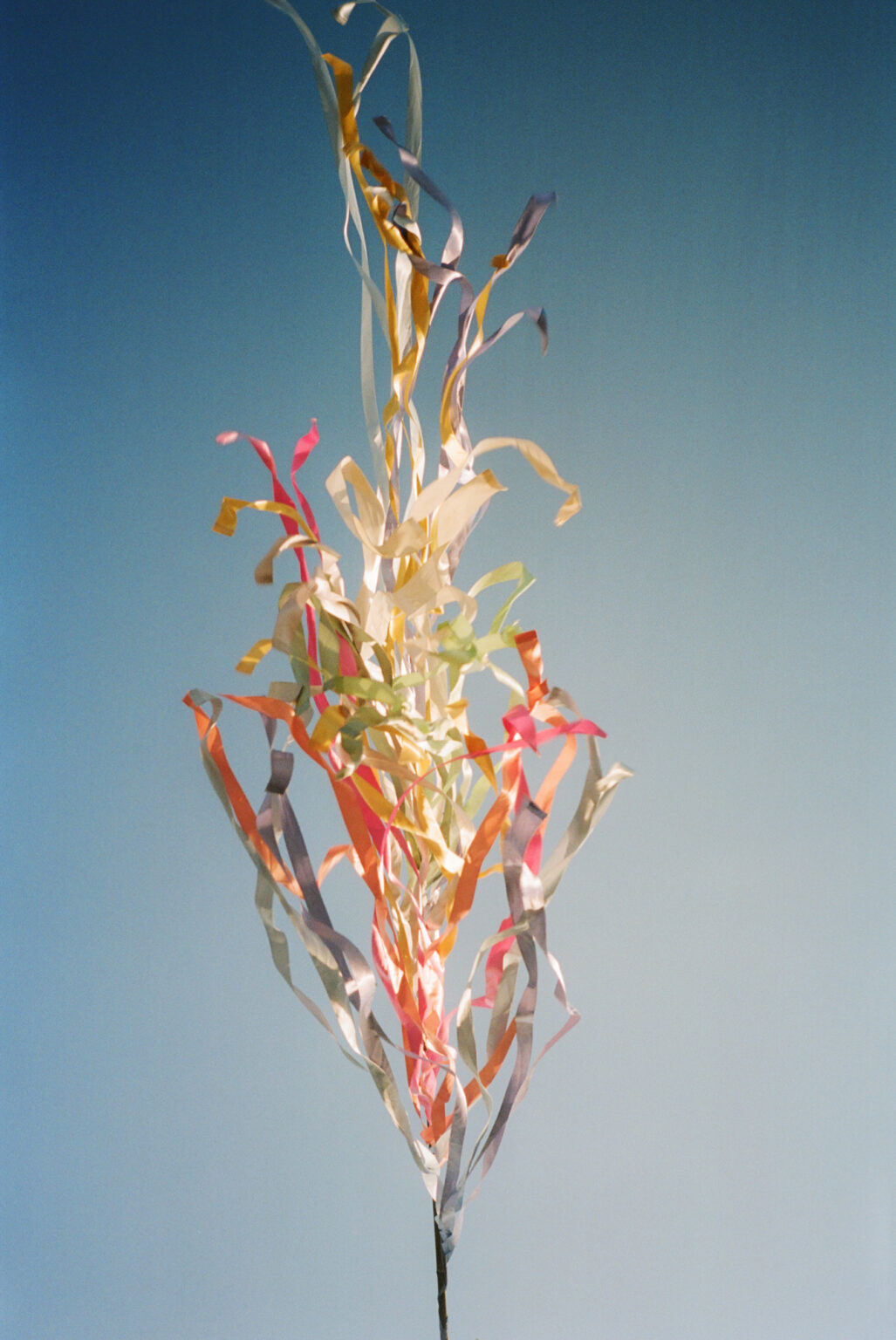
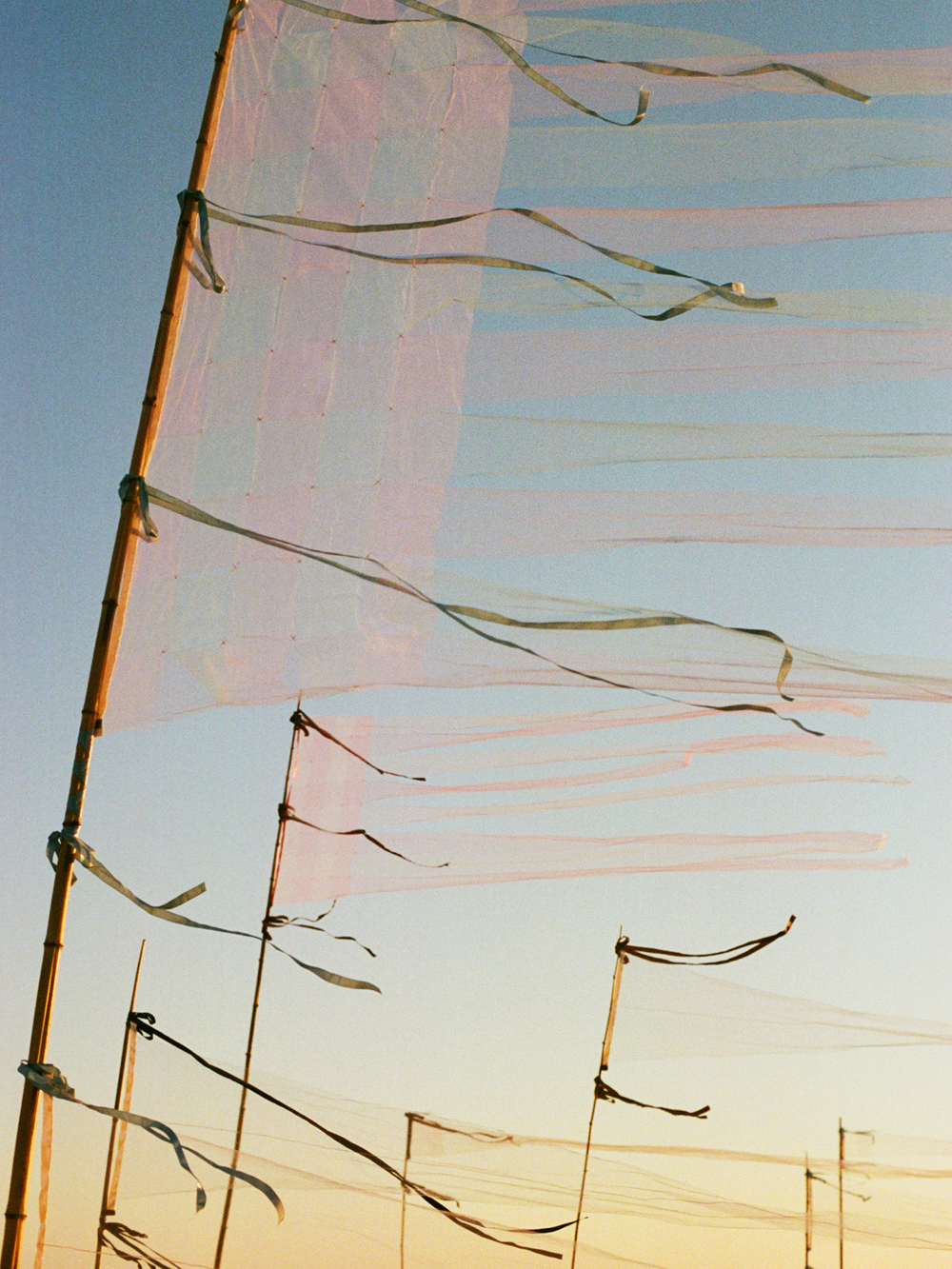
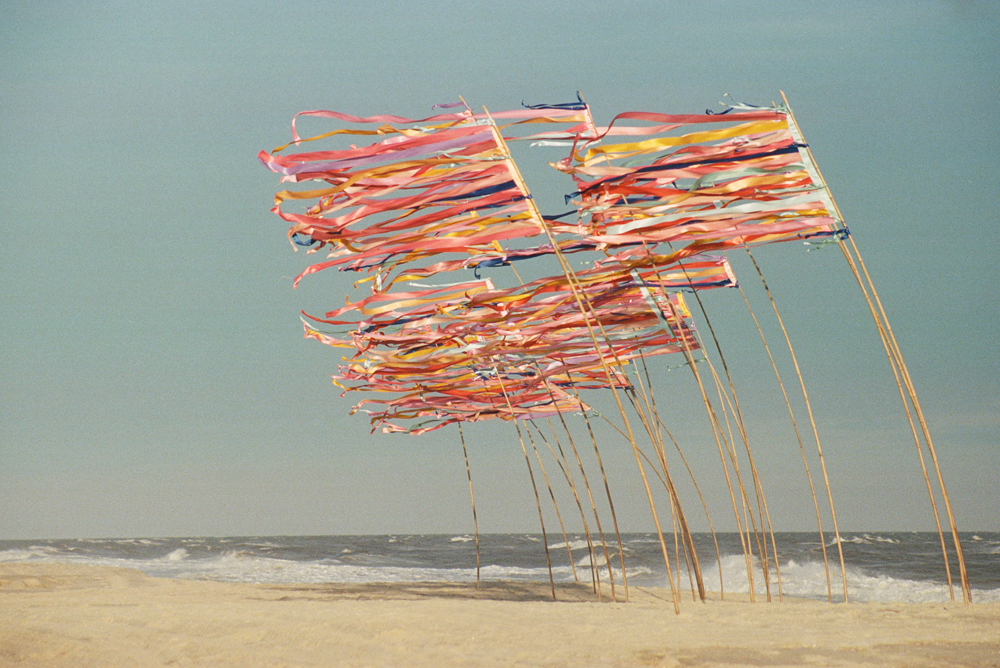
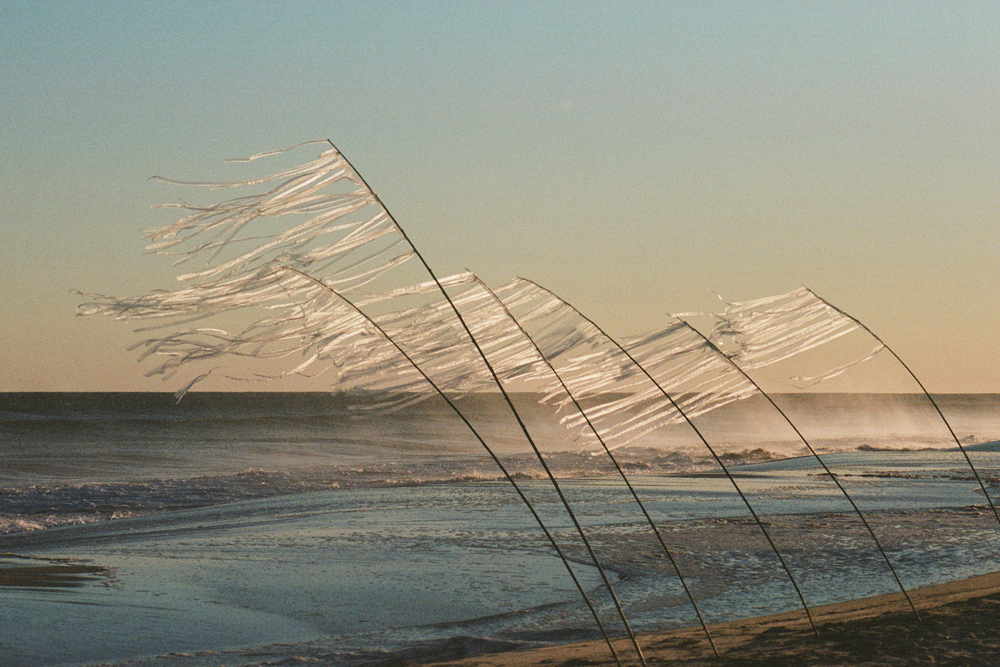
Edgar Mosa and Joe McShea photographed in Fire Island. September 2022.
On an evening like this, we would probably all be sitting together anyway. It is dusk, and against the sky’s gradient the white taffeta ribbons whipping in the wind are alight with the sunset. We watch them in silence, a group of ten gay men standing together alongside the artists Joe McShea and Edgar Mosa on an empty stretch of the beach on Fire Island between the Pines and Cherry Grove, in front of an undeveloped area of protected dunes and scrub forest known as the Meat Rack. They are nothing more than long strips of fabric sewn together at one end, and tied carefully to dried bamboo rods. It is mesmerizing the way the fabric ripples in the wind, and how the rods bend and sway. McShea and Mosa’s ephemeral flag installations have been bringing together a close community in the Pines, where in 2020 the artists began making little cities of them on the beach, the same year they started a house share at the height of Covid. On this night, the 26 flags fly in unison for just a few hours and act as a beacon, attracting people who are walking from way down the beach to come and see.
McShea and Mosa, who are partners in life as well as in their artistic practice, made their first flag works on an artist residency in Brescia in 2018, but the project really gained momentum as the island became a refuge for many of us who’d been stuck in New York, hit hard by the virus and an isolating lockdown. That summer, BOFFO, a not-for-profit that hosts an artist residency and public programming on Fire Island, began collaborating with McShea and Mosa, installing their flags at their weekly Sunday afternoon dance parties; in 2022, the organization acquired a set of flags to be used in perpetuity for their annual performance festival on the beach. Last year, Jonathan Anderson commissioned McShea and Mosa to create an installation of 87 flags for Loewe’s fall 2022 menswear show in Paris. For all this public activity, experiencing their installations on quiet evenings like this one, when McShea and Mosa put them up as a test for just an evening, feels like a tremendous gift. It is difficult to make art that carries with it that status.
The flags have a strong visual presence, and reminiscent of works by Felix Gonzales-Torres, they imbue something familiar, in this case ribbons, with a surprising gravity and power. Maximum impact comes out of an extreme economy of materials: the sand, wind, fabric, and bamboo rods. The simplest intervention in a specific context can be the most powerful work of contemporary art.
The flags delineate uninterrupted miles of the beach and create a social space: a dance floor, a performance space, a hang out area, a sculptural installation, like the site-specific works by Christo and Jeanne-Claude. When people dance together amidst the stand of flags, it makes me think of other queer artists who have used Fire Island as a subject and a backdrop for their artistic experimentation, like the photographs of PaJaMa (Paul Cadmus, Jared French, and Margaret French). They let me see myself in that long history and as a participant in radical artistic practice here now.
We might all have been here this evening anyway, late into September, sitting together huddled under blankets, watching the final rays of sun reflected in the exploding foam of the waves. The fluttering ribbons, however, seem to amplify what persists regardless of our gaze, the sunset, the glittering color of the water, the strength of the wind, and against the perfect gradient of the sky, the flags illuminate our aesthetic understanding of the world and each other.
This story was printed in GAYLETTER Issue 17.
Edgar Mosa and Joe McShea photographed in Fire Island. September 2022.
On an evening like this, we would probably all be sitting together anyway. It is dusk, and against the sky’s gradient the white taffeta ribbons whipping in the wind are alight with the sunset. We watch them in silence, a group of ten gay men standing together alongside the artists Joe McShea and Edgar Mosa on an empty stretch of the beach on Fire Island between the Pines and Cherry Grove, in front of an undeveloped area of protected dunes and scrub forest known as the Meat Rack. They are nothing more than long strips of fabric sewn together at one end, and tied carefully to dried bamboo rods. It is mesmerizing the way the fabric ripples in the wind, and how the rods bend and sway. McShea and Mosa’s ephemeral flag installations have been bringing together a close community in the Pines, where in 2020 the artists began making little cities of them on the beach, the same year they started a house share at the height of Covid. On this night, the 26 flags fly in unison for just a few hours and act as a beacon, attracting people who are walking from way down the beach to come and see.
McShea and Mosa, who are partners in life as well as in their artistic practice, made their first flag works on an artist residency in Brescia in 2018, but the project really gained momentum as the island became a refuge for many of us who’d been stuck in New York, hit hard by the virus and an isolating lockdown. That summer, BOFFO, a not-for-profit that hosts an artist residency and public programming on Fire Island, began collaborating with McShea and Mosa, installing their flags at their weekly Sunday afternoon dance parties; in 2022, the organization acquired a set of flags to be used in perpetuity for their annual performance festival on the beach. Last year, Jonathan Anderson commissioned McShea and Mosa to create an installation of 87 flags for Loewe’s fall 2022 menswear show in Paris. For all this public activity, experiencing their installations on quiet evenings like this one, when McShea and Mosa put them up as a test for just an evening, feels like a tremendous gift. It is difficult to make art that carries with it that status.
The flags have a strong visual presence, and reminiscent of works by Felix Gonzales-Torres, they imbue something familiar, in this case ribbons, with a surprising gravity and power. Maximum impact comes out of an extreme economy of materials: the sand, wind, fabric, and bamboo rods. The simplest intervention in a specific context can be the most powerful work of contemporary art.
The flags delineate uninterrupted miles of the beach and create a social space: a dance floor, a performance space, a hang out area, a sculptural installation, like the site-specific works by Christo and Jeanne-Claude. When people dance together amidst the stand of flags, it makes me think of other queer artists who have used Fire Island as a subject and a backdrop for their artistic experimentation, like the photographs of PaJaMa (Paul Cadmus, Jared French, and Margaret French). They let me see myself in that long history and as a participant in radical artistic practice here now.
We might all have been here this evening anyway, late into September, sitting together huddled under blankets, watching the final rays of sun reflected in the exploding foam of the waves. The fluttering ribbons, however, seem to amplify what persists regardless of our gaze, the sunset, the glittering color of the water, the strength of the wind, and against the perfect gradient of the sky, the flags illuminate our aesthetic understanding of the world and each other.
This story was printed in GAYLETTER Issue 17.
70 T-shirt flags were created for Loewe’s fall 2022 men’s show in Paris.
On an evening like this, we would probably all be sitting together anyway. It is dusk, and against the sky’s gradient the white taffeta ribbons whipping in the wind are alight with the sunset. We watch them in silence, a group of ten gay men standing together alongside the artists Joe McShea and Edgar Mosa on an empty stretch of the beach on Fire Island between the Pines and Cherry Grove, in front of an undeveloped area of protected dunes and scrub forest known as the Meat Rack. They are nothing more than long strips of fabric sewn together at one end, and tied carefully to dried bamboo rods. It is mesmerizing the way the fabric ripples in the wind, and how the rods bend and sway. McShea and Mosa’s ephemeral flag installations have been bringing together a close community in the Pines, where in 2020 the artists began making little cities of them on the beach, the same year they started a house share at the height of Covid. On this night, the 26 flags fly in unison for just a few hours and act as a beacon, attracting people who are walking from way down the beach to come and see.
McShea and Mosa, who are partners in life as well as in their artistic practice, made their first flag works on an artist residency in Brescia in 2018, but the project really gained momentum as the island became a refuge for many of us who’d been stuck in New York, hit hard by the virus and an isolating lockdown. That summer, BOFFO, a not-for-profit that hosts an artist residency and public programming on Fire Island, began collaborating with McShea and Mosa, installing their flags at their weekly Sunday afternoon dance parties; in 2022, the organization acquired a set of flags to be used in perpetuity for their annual performance festival on the beach. Last year, Jonathan Anderson commissioned McShea and Mosa to create an installation of 87 flags for Loewe’s fall 2022 menswear show in Paris. For all this public activity, experiencing their installations on quiet evenings like this one, when McShea and Mosa put them up as a test for just an evening, feels like a tremendous gift. It is difficult to make art that carries with it that status.
The flags have a strong visual presence, and reminiscent of works by Felix Gonzales-Torres, they imbue something familiar, in this case ribbons, with a surprising gravity and power. Maximum impact comes out of an extreme economy of materials: the sand, wind, fabric, and bamboo rods. The simplest intervention in a specific context can be the most powerful work of contemporary art.
The flags delineate uninterrupted miles of the beach and create a social space: a dance floor, a performance space, a hang out area, a sculptural installation, like the site-specific works by Christo and Jeanne-Claude. When people dance together amidst the stand of flags, it makes me think of other queer artists who have used Fire Island as a subject and a backdrop for their artistic experimentation, like the photographs of PaJaMa (Paul Cadmus, Jared French, and Margaret French). They let me see myself in that long history and as a participant in radical artistic practice here now.
We might all have been here this evening anyway, late into September, sitting together huddled under blankets, watching the final rays of sun reflected in the exploding foam of the waves. The fluttering ribbons, however, seem to amplify what persists regardless of our gaze, the sunset, the glittering color of the water, the strength of the wind, and against the perfect gradient of the sky, the flags illuminate our aesthetic understanding of the world and each other.
This story was printed in GAYLETTER Issue 17.
70 T-shirt flags were created for Loewe’s fall 2022 men’s show in Paris.
On an evening like this, we would probably all be sitting together anyway. It is dusk, and against the sky’s gradient the white taffeta ribbons whipping in the wind are alight with the sunset. We watch them in silence, a group of ten gay men standing together alongside the artists Joe McShea and Edgar Mosa on an empty stretch of the beach on Fire Island between the Pines and Cherry Grove, in front of an undeveloped area of protected dunes and scrub forest known as the Meat Rack. They are nothing more than long strips of fabric sewn together at one end, and tied carefully to dried bamboo rods. It is mesmerizing the way the fabric ripples in the wind, and how the rods bend and sway. McShea and Mosa’s ephemeral flag installations have been bringing together a close community in the Pines, where in 2020 the artists began making little cities of them on the beach, the same year they started a house share at the height of Covid. On this night, the 26 flags fly in unison for just a few hours and act as a beacon, attracting people who are walking from way down the beach to come and see.
McShea and Mosa, who are partners in life as well as in their artistic practice, made their first flag works on an artist residency in Brescia in 2018, but the project really gained momentum as the island became a refuge for many of us who’d been stuck in New York, hit hard by the virus and an isolating lockdown. That summer, BOFFO, a not-for-profit that hosts an artist residency and public programming on Fire Island, began collaborating with McShea and Mosa, installing their flags at their weekly Sunday afternoon dance parties; in 2022, the organization acquired a set of flags to be used in perpetuity for their annual performance festival on the beach. Last year, Jonathan Anderson commissioned McShea and Mosa to create an installation of 87 flags for Loewe’s fall 2022 menswear show in Paris. For all this public activity, experiencing their installations on quiet evenings like this one, when McShea and Mosa put them up as a test for just an evening, feels like a tremendous gift. It is difficult to make art that carries with it that status.
The flags have a strong visual presence, and reminiscent of works by Felix Gonzales-Torres, they imbue something familiar, in this case ribbons, with a surprising gravity and power. Maximum impact comes out of an extreme economy of materials: the sand, wind, fabric, and bamboo rods. The simplest intervention in a specific context can be the most powerful work of contemporary art.
The flags delineate uninterrupted miles of the beach and create a social space: a dance floor, a performance space, a hang out area, a sculptural installation, like the site-specific works by Christo and Jeanne-Claude. When people dance together amidst the stand of flags, it makes me think of other queer artists who have used Fire Island as a subject and a backdrop for their artistic experimentation, like the photographs of PaJaMa (Paul Cadmus, Jared French, and Margaret French). They let me see myself in that long history and as a participant in radical artistic practice here now.
We might all have been here this evening anyway, late into September, sitting together huddled under blankets, watching the final rays of sun reflected in the exploding foam of the waves. The fluttering ribbons, however, seem to amplify what persists regardless of our gaze, the sunset, the glittering color of the water, the strength of the wind, and against the perfect gradient of the sky, the flags illuminate our aesthetic understanding of the world and each other.
This story was printed in GAYLETTER Issue 17.
The BOFFO Annual Performance Festival on Fire Island.
On an evening like this, we would probably all be sitting together anyway. It is dusk, and against the sky’s gradient the white taffeta ribbons whipping in the wind are alight with the sunset. We watch them in silence, a group of ten gay men standing together alongside the artists Joe McShea and Edgar Mosa on an empty stretch of the beach on Fire Island between the Pines and Cherry Grove, in front of an undeveloped area of protected dunes and scrub forest known as the Meat Rack. They are nothing more than long strips of fabric sewn together at one end, and tied carefully to dried bamboo rods. It is mesmerizing the way the fabric ripples in the wind, and how the rods bend and sway. McShea and Mosa’s ephemeral flag installations have been bringing together a close community in the Pines, where in 2020 the artists began making little cities of them on the beach, the same year they started a house share at the height of Covid. On this night, the 26 flags fly in unison for just a few hours and act as a beacon, attracting people who are walking from way down the beach to come and see.
McShea and Mosa, who are partners in life as well as in their artistic practice, made their first flag works on an artist residency in Brescia in 2018, but the project really gained momentum as the island became a refuge for many of us who’d been stuck in New York, hit hard by the virus and an isolating lockdown. That summer, BOFFO, a not-for-profit that hosts an artist residency and public programming on Fire Island, began collaborating with McShea and Mosa, installing their flags at their weekly Sunday afternoon dance parties; in 2022, the organization acquired a set of flags to be used in perpetuity for their annual performance festival on the beach. Last year, Jonathan Anderson commissioned McShea and Mosa to create an installation of 87 flags for Loewe’s fall 2022 menswear show in Paris. For all this public activity, experiencing their installations on quiet evenings like this one, when McShea and Mosa put them up as a test for just an evening, feels like a tremendous gift. It is difficult to make art that carries with it that status.
The flags have a strong visual presence, and reminiscent of works by Felix Gonzales-Torres, they imbue something familiar, in this case ribbons, with a surprising gravity and power. Maximum impact comes out of an extreme economy of materials: the sand, wind, fabric, and bamboo rods. The simplest intervention in a specific context can be the most powerful work of contemporary art.
The flags delineate uninterrupted miles of the beach and create a social space: a dance floor, a performance space, a hang out area, a sculptural installation, like the site-specific works by Christo and Jeanne-Claude. When people dance together amidst the stand of flags, it makes me think of other queer artists who have used Fire Island as a subject and a backdrop for their artistic experimentation, like the photographs of PaJaMa (Paul Cadmus, Jared French, and Margaret French). They let me see myself in that long history and as a participant in radical artistic practice here now.
We might all have been here this evening anyway, late into September, sitting together huddled under blankets, watching the final rays of sun reflected in the exploding foam of the waves. The fluttering ribbons, however, seem to amplify what persists regardless of our gaze, the sunset, the glittering color of the water, the strength of the wind, and against the perfect gradient of the sky, the flags illuminate our aesthetic understanding of the world and each other.
This story was printed in GAYLETTER Issue 17.
Flag detail, August 2022.
On an evening like this, we would probably all be sitting together anyway. It is dusk, and against the sky’s gradient the white taffeta ribbons whipping in the wind are alight with the sunset. We watch them in silence, a group of ten gay men standing together alongside the artists Joe McShea and Edgar Mosa on an empty stretch of the beach on Fire Island between the Pines and Cherry Grove, in front of an undeveloped area of protected dunes and scrub forest known as the Meat Rack. They are nothing more than long strips of fabric sewn together at one end, and tied carefully to dried bamboo rods. It is mesmerizing the way the fabric ripples in the wind, and how the rods bend and sway. McShea and Mosa’s ephemeral flag installations have been bringing together a close community in the Pines, where in 2020 the artists began making little cities of them on the beach, the same year they started a house share at the height of Covid. On this night, the 26 flags fly in unison for just a few hours and act as a beacon, attracting people who are walking from way down the beach to come and see.
McShea and Mosa, who are partners in life as well as in their artistic practice, made their first flag works on an artist residency in Brescia in 2018, but the project really gained momentum as the island became a refuge for many of us who’d been stuck in New York, hit hard by the virus and an isolating lockdown. That summer, BOFFO, a not-for-profit that hosts an artist residency and public programming on Fire Island, began collaborating with McShea and Mosa, installing their flags at their weekly Sunday afternoon dance parties; in 2022, the organization acquired a set of flags to be used in perpetuity for their annual performance festival on the beach. Last year, Jonathan Anderson commissioned McShea and Mosa to create an installation of 87 flags for Loewe’s fall 2022 menswear show in Paris. For all this public activity, experiencing their installations on quiet evenings like this one, when McShea and Mosa put them up as a test for just an evening, feels like a tremendous gift. It is difficult to make art that carries with it that status.
The flags have a strong visual presence, and reminiscent of works by Felix Gonzales-Torres, they imbue something familiar, in this case ribbons, with a surprising gravity and power. Maximum impact comes out of an extreme economy of materials: the sand, wind, fabric, and bamboo rods. The simplest intervention in a specific context can be the most powerful work of contemporary art.
The flags delineate uninterrupted miles of the beach and create a social space: a dance floor, a performance space, a hang out area, a sculptural installation, like the site-specific works by Christo and Jeanne-Claude. When people dance together amidst the stand of flags, it makes me think of other queer artists who have used Fire Island as a subject and a backdrop for their artistic experimentation, like the photographs of PaJaMa (Paul Cadmus, Jared French, and Margaret French). They let me see myself in that long history and as a participant in radical artistic practice here now.
We might all have been here this evening anyway, late into September, sitting together huddled under blankets, watching the final rays of sun reflected in the exploding foam of the waves. The fluttering ribbons, however, seem to amplify what persists regardless of our gaze, the sunset, the glittering color of the water, the strength of the wind, and against the perfect gradient of the sky, the flags illuminate our aesthetic understanding of the world and each other.
This story was printed in GAYLETTER Issue 17.
Installation for the 2021’s BOFFO Festival photographed by Joe McShea.
On an evening like this, we would probably all be sitting together anyway. It is dusk, and against the sky’s gradient the white taffeta ribbons whipping in the wind are alight with the sunset. We watch them in silence, a group of ten gay men standing together alongside the artists Joe McShea and Edgar Mosa on an empty stretch of the beach on Fire Island between the Pines and Cherry Grove, in front of an undeveloped area of protected dunes and scrub forest known as the Meat Rack. They are nothing more than long strips of fabric sewn together at one end, and tied carefully to dried bamboo rods. It is mesmerizing the way the fabric ripples in the wind, and how the rods bend and sway. McShea and Mosa’s ephemeral flag installations have been bringing together a close community in the Pines, where in 2020 the artists began making little cities of them on the beach, the same year they started a house share at the height of Covid. On this night, the 26 flags fly in unison for just a few hours and act as a beacon, attracting people who are walking from way down the beach to come and see.
McShea and Mosa, who are partners in life as well as in their artistic practice, made their first flag works on an artist residency in Brescia in 2018, but the project really gained momentum as the island became a refuge for many of us who’d been stuck in New York, hit hard by the virus and an isolating lockdown. That summer, BOFFO, a not-for-profit that hosts an artist residency and public programming on Fire Island, began collaborating with McShea and Mosa, installing their flags at their weekly Sunday afternoon dance parties; in 2022, the organization acquired a set of flags to be used in perpetuity for their annual performance festival on the beach. Last year, Jonathan Anderson commissioned McShea and Mosa to create an installation of 87 flags for Loewe’s fall 2022 menswear show in Paris. For all this public activity, experiencing their installations on quiet evenings like this one, when McShea and Mosa put them up as a test for just an evening, feels like a tremendous gift. It is difficult to make art that carries with it that status.
The flags have a strong visual presence, and reminiscent of works by Felix Gonzales-Torres, they imbue something familiar, in this case ribbons, with a surprising gravity and power. Maximum impact comes out of an extreme economy of materials: the sand, wind, fabric, and bamboo rods. The simplest intervention in a specific context can be the most powerful work of contemporary art.
The flags delineate uninterrupted miles of the beach and create a social space: a dance floor, a performance space, a hang out area, a sculptural installation, like the site-specific works by Christo and Jeanne-Claude. When people dance together amidst the stand of flags, it makes me think of other queer artists who have used Fire Island as a subject and a backdrop for their artistic experimentation, like the photographs of PaJaMa (Paul Cadmus, Jared French, and Margaret French). They let me see myself in that long history and as a participant in radical artistic practice here now.
We might all have been here this evening anyway, late into September, sitting together huddled under blankets, watching the final rays of sun reflected in the exploding foam of the waves. The fluttering ribbons, however, seem to amplify what persists regardless of our gaze, the sunset, the glittering color of the water, the strength of the wind, and against the perfect gradient of the sky, the flags illuminate our aesthetic understanding of the world and each other.
This story was printed in GAYLETTER Issue 17.
Flags, Fire Island, August 2022. Photographed by Joe McShea.
On an evening like this, we would probably all be sitting together anyway. It is dusk, and against the sky’s gradient the white taffeta ribbons whipping in the wind are alight with the sunset. We watch them in silence, a group of ten gay men standing together alongside the artists Joe McShea and Edgar Mosa on an empty stretch of the beach on Fire Island between the Pines and Cherry Grove, in front of an undeveloped area of protected dunes and scrub forest known as the Meat Rack. They are nothing more than long strips of fabric sewn together at one end, and tied carefully to dried bamboo rods. It is mesmerizing the way the fabric ripples in the wind, and how the rods bend and sway. McShea and Mosa’s ephemeral flag installations have been bringing together a close community in the Pines, where in 2020 the artists began making little cities of them on the beach, the same year they started a house share at the height of Covid. On this night, the 26 flags fly in unison for just a few hours and act as a beacon, attracting people who are walking from way down the beach to come and see.
McShea and Mosa, who are partners in life as well as in their artistic practice, made their first flag works on an artist residency in Brescia in 2018, but the project really gained momentum as the island became a refuge for many of us who’d been stuck in New York, hit hard by the virus and an isolating lockdown. That summer, BOFFO, a not-for-profit that hosts an artist residency and public programming on Fire Island, began collaborating with McShea and Mosa, installing their flags at their weekly Sunday afternoon dance parties; in 2022, the organization acquired a set of flags to be used in perpetuity for their annual performance festival on the beach. Last year, Jonathan Anderson commissioned McShea and Mosa to create an installation of 87 flags for Loewe’s fall 2022 menswear show in Paris. For all this public activity, experiencing their installations on quiet evenings like this one, when McShea and Mosa put them up as a test for just an evening, feels like a tremendous gift. It is difficult to make art that carries with it that status.
The flags have a strong visual presence, and reminiscent of works by Felix Gonzales-Torres, they imbue something familiar, in this case ribbons, with a surprising gravity and power. Maximum impact comes out of an extreme economy of materials: the sand, wind, fabric, and bamboo rods. The simplest intervention in a specific context can be the most powerful work of contemporary art.
The flags delineate uninterrupted miles of the beach and create a social space: a dance floor, a performance space, a hang out area, a sculptural installation, like the site-specific works by Christo and Jeanne-Claude. When people dance together amidst the stand of flags, it makes me think of other queer artists who have used Fire Island as a subject and a backdrop for their artistic experimentation, like the photographs of PaJaMa (Paul Cadmus, Jared French, and Margaret French). They let me see myself in that long history and as a participant in radical artistic practice here now.
We might all have been here this evening anyway, late into September, sitting together huddled under blankets, watching the final rays of sun reflected in the exploding foam of the waves. The fluttering ribbons, however, seem to amplify what persists regardless of our gaze, the sunset, the glittering color of the water, the strength of the wind, and against the perfect gradient of the sky, the flags illuminate our aesthetic understanding of the world and each other.
This story was printed in GAYLETTER Issue 17.
Flags, Fire Island, April 2022. Photographed by Joe McShea.
On an evening like this, we would probably all be sitting together anyway. It is dusk, and against the sky’s gradient the white taffeta ribbons whipping in the wind are alight with the sunset. We watch them in silence, a group of ten gay men standing together alongside the artists Joe McShea and Edgar Mosa on an empty stretch of the beach on Fire Island between the Pines and Cherry Grove, in front of an undeveloped area of protected dunes and scrub forest known as the Meat Rack. They are nothing more than long strips of fabric sewn together at one end, and tied carefully to dried bamboo rods. It is mesmerizing the way the fabric ripples in the wind, and how the rods bend and sway. McShea and Mosa’s ephemeral flag installations have been bringing together a close community in the Pines, where in 2020 the artists began making little cities of them on the beach, the same year they started a house share at the height of Covid. On this night, the 26 flags fly in unison for just a few hours and act as a beacon, attracting people who are walking from way down the beach to come and see.
McShea and Mosa, who are partners in life as well as in their artistic practice, made their first flag works on an artist residency in Brescia in 2018, but the project really gained momentum as the island became a refuge for many of us who’d been stuck in New York, hit hard by the virus and an isolating lockdown. That summer, BOFFO, a not-for-profit that hosts an artist residency and public programming on Fire Island, began collaborating with McShea and Mosa, installing their flags at their weekly Sunday afternoon dance parties; in 2022, the organization acquired a set of flags to be used in perpetuity for their annual performance festival on the beach. Last year, Jonathan Anderson commissioned McShea and Mosa to create an installation of 87 flags for Loewe’s fall 2022 menswear show in Paris. For all this public activity, experiencing their installations on quiet evenings like this one, when McShea and Mosa put them up as a test for just an evening, feels like a tremendous gift. It is difficult to make art that carries with it that status.
The flags have a strong visual presence, and reminiscent of works by Felix Gonzales-Torres, they imbue something familiar, in this case ribbons, with a surprising gravity and power. Maximum impact comes out of an extreme economy of materials: the sand, wind, fabric, and bamboo rods. The simplest intervention in a specific context can be the most powerful work of contemporary art.
The flags delineate uninterrupted miles of the beach and create a social space: a dance floor, a performance space, a hang out area, a sculptural installation, like the site-specific works by Christo and Jeanne-Claude. When people dance together amidst the stand of flags, it makes me think of other queer artists who have used Fire Island as a subject and a backdrop for their artistic experimentation, like the photographs of PaJaMa (Paul Cadmus, Jared French, and Margaret French). They let me see myself in that long history and as a participant in radical artistic practice here now.
We might all have been here this evening anyway, late into September, sitting together huddled under blankets, watching the final rays of sun reflected in the exploding foam of the waves. The fluttering ribbons, however, seem to amplify what persists regardless of our gaze, the sunset, the glittering color of the water, the strength of the wind, and against the perfect gradient of the sky, the flags illuminate our aesthetic understanding of the world and each other.
This story was printed in GAYLETTER Issue 17.
1/9